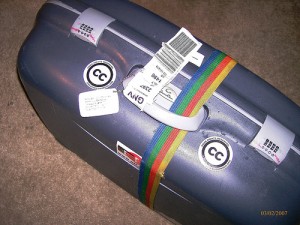I couldn't say it better. Jeff Plaman has just just responded to a posting by Kim Cofino regarding how to know where to go for your next tech job. What is the right fit?
I LOVE where I am, I hope you do as well. Best of luck in your move Jeff. We are about to take our first steps into the 1:1 arena. Next week is our first out of the box training with teachers. I better get busy and get caught up on some of the steps we've taken so far.
I am re-posting this in it's entirety ... these are great thoughts.
Until next time ...
Dave
-------------------------------------
Oh, the places you’ll go
Congratulations!
Today is your day.
You’re off to Great Places!
You’re off and away!
Seuss
This is the time of year when many international teachers are abuzz with the emotions surrounding recruitment.

Travel in Style
Excitement about a new job for yourself or a friend, sadness over missed opportunities or colleagues who are moving, and lots of uncertainty about whether to leave perhaps or about the new places you’ll go.
I’m sorry to say so
but, sadly, it’s true
that Bang-ups
and Hang-ups
can happen to you.
Seuss
I’ve been confronted with all these emotions and then some again this year as I wrestled with the difficult decision to uproot my family and leave my current school and pursue a unique opportunity at United World College of South East Asia in Singapore.
Kim Cofino helped clarify for me just how important finding the right fit is.
One thing I didn’t truly understand until this year is just how important it is to find the right fit – for you and the school.
Kim’s post couldn’t have been more timely. She goes on to list size, location, curriculum, student body, and of course technology which is what really resonated with me and ended up being a major factor in my decision to pursue the new job.
One is how the technology department views the use of technology in the classroom – are teachers given admin rights over their own computer, how many and what type of websites are blocked at school, what kind of access do students have to technology (can they bring their own devices and get on the school network), and what is the department (and the school’s) vision for technology? There are still many international schools that have a philosophy of control rather than support and collaboration.
I can’t really come up with a better list of questions about the school’s view of technology. Most of all, it’s really important to drill down with as many questions as possible to identify whether the model is control versus collaboration. As Kim identifies, a question which gives you a very good clue where they stand is whether staff (and students) have admin rights on their machines.
Though there are certainly exceptions, how a school answers this one question, and how they defend it, can tell you a great deal about their technology philosophy reflected in current practice.
No: could be a warning flag that the school views technology from a “command and control” standpoint. We give you the hardware, software, and settings you will use and tell you what we want you to do with it.
Yes: likely means that the school’s IT department is functioning with an emphasis on service. These are options that we can offer you, but we’d like you to tell us what you need to be a successful teacher and we’ll do our best to respond to those needs. You have the ability to customize the OS and software to meet your needs.
Taking a hard, honest look at this one question helped clarify the right decision for me. UWCSEA has put a lot of time and effort into developing their iLearn initiative which spells out their philosophy and direction clearly including not just adoption of a 1-1 Mac platform but how they expect the technology to be used, staff support and development, and recruitment implications. I’m happy to report that I’ll be moving to UWCSEA in August 2011 and I wish you all luck with your important decisions.
And will you succeed?
Yes! You will, indeed!
(98 and 3/4 percent guaranteed.)
Seuss
Seuss. Oh, the Places You’ll Go! New York: Random House, 1990. Print.


 It has been coming increasingly important to get students involved in the planning and carrying out of the technology plan. One of the aspects of that plan is how to anticipate and problem solve situations that don’t exist. One person and even one department will have a difficult time keeping up with the task.
It has been coming increasingly important to get students involved in the planning and carrying out of the technology plan. One of the aspects of that plan is how to anticipate and problem solve situations that don’t exist. One person and even one department will have a difficult time keeping up with the task. 